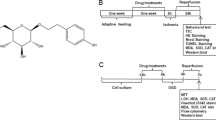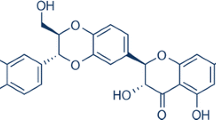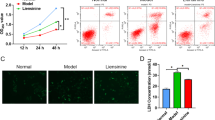Abstract
Salidroside (SAL), an antioxidant derived from Rhodiola rosea, exerts neuroprotective effects in cerebral ischemia/reperfusion (I/R) injury; however, the mechanisms have not been fully elucidated. The present study established a rat model of middle cerebral artery occlusion/reperfusion (MCAO/R) and a cellular model of oxygen–glucose deprivation/reoxygenation (OGD/R) to explore the roles and mechanisms of SAL in cerebral I/R injury. The rat model of MCAO/R was established and rats were treated with different doses of SAL. The Zea-Longa scoring system and 2,3,5-triphenyltetrazolium chloride (TTC) staining showed that SAL reduced neurological deficit scores and cerebral infarct volumes in MCAO/R rats. The results of Morris water maze (MWM) test showed that SAL reduced memory impairment in MCAO/R rats. In addition, SAL significantly reduced oxidative stress and suppressed inflammatory response. Next, the OGD/R model was established with PC12 cells and treated with SAL. The results of flow cytometry and 3-(4, 5-dimethylthiazolyl-2)-2,5-diphenyltetrazolium bromide (MTT) assays showed that SAL reduced apoptosis, enhanced cell viability and protected neuronal cells from damage by decreasing lactate dehydrogenase (LDH) activity. SAL increased the expression of TSC complex subunit 2 (TSC2), and activated the 5′-AMP-activated protein kinase (AMPK) and inhibited the mammalian target of rapamycin (mTOR) signaling pathways. It was verified that SAL alleviated cerebral I/R injury by regulating the AMPK/TSC2/mTOR pathway to induce autophagy. In conclusion, SAL reduces the inflammatory response and oxidative stress in a concentration-dependent manner, and protects against cerebral I/R injury by modulating TSC2-induced autophagy. These findings suggest SAL may prove to be a potential therapeutic agent for ischemic stroke.







Similar content being viewed by others
Availability of supporting data
The datasets used and/or analyzed during the current study are available from the corresponding author on reasonable request.
References
Ajoolabady A, Wang S, Kroemer G et al (2021) Targeting autophagy in ischemic stroke: from molecular mechanisms to clinical therapeutics. Pharmacol Ther 225:107848
Bao MH, Szeto V, Yang BB, Zhu SZ, Sun HS, Feng ZP (2018) Long non-coding RNAs in ischemic stroke. Cell Death Dis 9:281
Barthels D, Das H (2020) Current advances in ischemic stroke research and therapies. Biochim Biophys Acta Mol Basis Dis 1866:165260
Bonfante S, Della Giustina A, Danielski LG et al (2020) Stanniocalcin-1 ameliorates cerebral ischemia by decrease oxidative stress and blood brain barrier permeability. Microvasc Res 128:103956
Chen T, Ma Z, Zhu L et al (2016) Suppressing receptor-interacting protein 140: a new sight for salidroside to treat cerebral ischemia. Mol Neurobiol 53:6240–6250
Chiang T, Messing RO, Chou WH (2011) Mouse model of middle cerebral artery occlusion. J Visual Exp JoVE. https://doi.org/10.3791/2761
Dunbar M, Kirton A (2019) Perinatal stroke. Semin Pediatr Neurol 32:100767
Fan F, Yang L, Li R et al (2020) Salidroside as a potential neuroprotective agent for ischemic stroke: a review of sources, pharmacokinetics, mechanism and safety. Biomed Pharmacother 129:110458
Feng J, Niu P, Chen K et al (2018a) Salidroside mediates apoptosis and autophagy inhibition in concanavalin A-induced liver injury. Exp Ther Med 15:4599–4614
Feng J, Chen K, Xia Y et al (2018b) Salidroside ameliorates autophagy and activation of hepatic stellate cells in mice via NF-kappaB and TGF-beta1/Smad3 pathways. Drug Des Dev Ther 12:1837–1853
Fluck F, Augustin AM, Bley T, Kickuth R (2020) Current treatment options in acute limb ischemia. RoFo : Fortschritte Auf Dem Gebiete Der Rontgenstrahlen Und Der Nuklearmedizin 192:319–326
Gao XJ, Xie GN, Liu L, Fu ZJ, Zhang ZW, Teng LZ (2017) Sesamol attenuates oxidative stress, apoptosis and inflammation in focal cerebral ischemia/reperfusion injury. Exp Ther Med 14:841–847
Gong L, Tang Y, An R, Lin M, Chen L, Du J (2017) RTN1-C mediates cerebral ischemia/reperfusion injury via ER stress and mitochondria-associated apoptosis pathways. Cell Death Dis 8:e3080
Guan X, Li X, Yang X et al (2019) The neuroprotective effects of carvacrol on ischemia/reperfusion-induced hippocampal neuronal impairment by ferroptosis mitigation. Life Sci 235:116795
Gui D, Cui Z, Zhang L et al (2017) Salidroside attenuates hypoxia-induced pulmonary arterial smooth muscle cell proliferation and apoptosis resistance by upregulating autophagy through the AMPK-mTOR-ULK1 pathway. BMC Pulm Med 17:191
He J, Zhou D, Yan B (2020) Eriocitrin alleviates oxidative stress and inflammatory response in cerebral ischemia reperfusion rats by regulating phosphorylation levels of Nrf2/NQO-1/HO-1/NF-kappaB p65 proteins. Ann Transl Med 8:757
Hu S, Wu Y, Zhao B et al (2018) Panax notoginseng saponins protect cerebral microvascular endothelial cells against oxygen-glucose deprivation/reperfusion-induced barrier dysfunction via activation of PI3K/Akt/Nrf2 antioxidant signaling pathway. Molecules 23:2781
Jin M, Wang C, Xu Y, Zhang Z, Wu X, Ye R, Zhang Q, Han D (2022) Pharmacological effects of salidroside on central nervous system diseases. Biomed Pharmacother 156:113746
Ke J, Wang J, Wu X, Yan Y (2022) Salidroside ameliorates ultraviolet-induced keratinocyte injury by inducing SIRT1-dependent autophagy. Clin Cosmet Investig Dermatol 15:1499–1508
Kumar P, Nagarajan A and Uchil PD (2018) analysis of cell viability by the MTT assay. Cold Spring Harbor Protoc 2018
Li P, Stetler RA, Leak RK et al (2018) Oxidative stress and DNA damage after cerebral ischemia: Potential therapeutic targets to repair the genome and improve stroke recovery. Neuropharmacology 134:208–217
Li F, Mao Q, Wang J, Zhang X, Lv X, Wu B, Yan T, Jia Y (2022) Salidroside inhibited cerebral ischemia/reperfusion-induced oxidative stress and apoptosis via Nrf2/Trx1 signaling pathway. Metab Brain Dis. https://doi.org/10.1007/s11011-022-01061-x (online ahead of print)
Longa EZ, Weinstein PR, Carlson S, Cummins R (1989) Reversible middle cerebral artery occlusion without craniectomy in rats. Stroke 20:84–91
Mehta SL, Manhas N, Raghubir R (2007) Molecular targets in cerebral ischemia for developing novel therapeutics. Brain Res Rev 54:34–66
Pei D, Tian S, Bao Y, Zhang J, Xu D, Piao M (2022) Protective effect of salidroside on streptozotocin-induced diabetic nephropathy by inhibiting oxidative stress and inflammation in rats via the Akt/GSK-3β signalling pathway. Pharm Biol 60:1732–1738
Peng J, Wang H, Gong Z et al (2020) Idebenone attenuates cerebral inflammatory injury in ischemia and reperfusion via dampening NLRP3 inflammasome activity. Mol Immunol 123:74–87
Shi CX, Jin J, Wang XQ et al (2020) Sevoflurane attenuates brain damage through inhibiting autophagy and apoptosis in cerebral ischemia-reperfusion rats. Mol Med Rep 21:123–130
Sun AQ, Ju XL (2021) Advances in research on anticancer properties of salidroside. Chin J Integr Med 27:153–160
Sun X, Wang D, Zhang T et al (2020a) Eugenol attenuates cerebral ischemia-reperfusion injury by enhancing autophagy via AMPK-mTOR-P70S6K pathway. Front Pharmacol 11:84
Sun S, Tuo Q, Li D et al (2020b) Antioxidant effects of salidroside in the cardiovascular system. Evid Based Complement Altern Med Ecam 2020:9568647
Tucker LB, Velosky AG, McCabe JT (2018) Applications of the Morris water maze in translational traumatic brain injury research. Neurosci Biobehav Rev 88:187–200
Wang G, Wang T, Zhang Y, Li F, Yu B, Kou J (2019) Schizandrin protects against OGD/R-induced neuronal injury by suppressing autophagy: involvement of the AMPK/mTOR pathway. Molecules 24:3624
Wu R, Li X, Xu P et al (2017) TREM2 protects against cerebral ischemia/reperfusion injury. Mol Brain 10:20
Yao L, Chen H, Wu Q, Xie K (2019) Hydrogen-rich saline alleviates inflammation and apoptosis in myocardial I/R injury via PINK-mediated autophagy. Int J Mol Med 44:1048–1062
Yin WY, Ye Q, Huang HJ et al (2016) Salidroside protects cortical neurons against glutamate-induced cytotoxicity by inhibiting autophagy. Mol Cell Biochem 419:53–64
You L, Zhang D, Geng H, Sun F, Lei M (2021) Salidroside protects endothelial cells against LPS-induced inflammatory injury by inhibiting NLRP3 and enhancing autophagy. BMC Complement Med Ther 21:146
Yu S, Liu M, Gu X, Ding F (2008) Neuroprotective effects of salidroside in the PC12 cell model exposed to hypoglycemia and serum limitation. Cell Mol Neurobiol 28:1067–1078
Yu S, Yu M, He X, Wen L, Bu Z, Feng J (2019) KCNQ1OT1 promotes autophagy by regulating miR-200a/FOXO3/ATG7 pathway in cerebral ischemic stroke. Aging Cell 18:e12940
Zha H, Fan Y, Yang L et al (2021) Autophagy protects against cerebral ischemic reperfusion injury by inhibiting neuroinflammation. Am J Transl Res 13:4726–4737
Zhang X, Du Q, Yang Y et al (2018) Salidroside alleviates ischemic brain injury in mice with ischemic stroke through regulating BDNK mediated PI3K/Akt pathway. Biochem Pharmacol 156:99–108
Zheng L, Tang X, Lu M et al (2020) microRNA-421-3p prevents inflammatory response in cerebral ischemia/reperfusion injury through targeting m6A Reader YTHDF1 to inhibit p65 mRNA translation. Int Immunopharmacol 88:106937
Zhou L, Song Z, Zhou L et al (2018) Protective role of astragalus injection in spinal cord ischemia-reperfusion injury in rats. Neurosciences 23:116–121
Zhu Z, Li J, Zhang X (2019) Salidroside protects against ox-LDL-induced endothelial injury by enhancing autophagy mediated by SIRT1-FoxO1 pathway. BMC Complement Altern Med 19:111
Acknowledgements
Not applicable.
Funding
The present study was supported by Xinjiang Uygur Autonomous Region Health young medical science and technology talents special research project (No. wjwy-202026) and General projects of Natural Science Foundation of Xinjiang Uygur Autonomous Region (No. 2021D01C131).
Author information
Authors and Affiliations
Contributions
CL conducted the conception and design, HD performed the animal study; JC analyzed the data; YW, ST drafted the manuscript; HZ did the literature research; HX conducted the conception and design, revised the manuscript. CL and HX confirm the authenticity of all the raw data.
Corresponding author
Ethics declarations
Conflict of interest
The authors have no conflicts of interest to declare.
Ethical approval and consent to participate
All animal experiments were approved by the Animal Ethics Council of People’s Hospital of Xinjiang Uygur Autonomous Region (No. 2020–03241).
Consent for publication
Not applicable.
Additional information
Communicated by Sreedharan Sajikumar.
Publisher's Note
Springer Nature remains neutral with regard to jurisdictional claims in published maps and institutional affiliations.
Rights and permissions
Springer Nature or its licensor (e.g. a society or other partner) holds exclusive rights to this article under a publishing agreement with the author(s) or other rightsholder(s); author self-archiving of the accepted manuscript version of this article is solely governed by the terms of such publishing agreement and applicable law.
About this article
Cite this article
Li, C., Chi, J., Dai, H. et al. Salidroside attenuates cerebral ischemia/reperfusion injury by regulating TSC2-induced autophagy. Exp Brain Res 241, 113–125 (2023). https://doi.org/10.1007/s00221-022-06493-6
Received:
Accepted:
Published:
Issue Date:
DOI: https://doi.org/10.1007/s00221-022-06493-6




